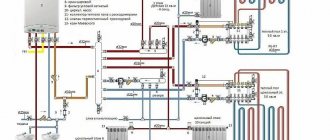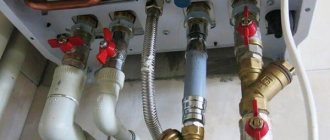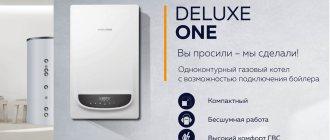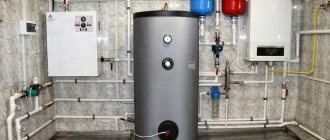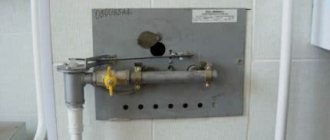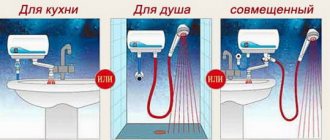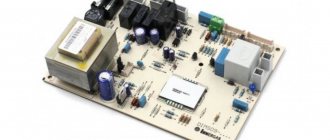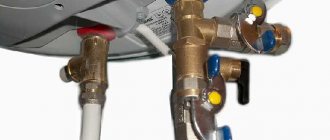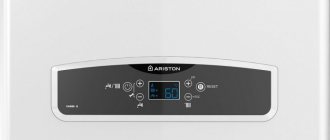Connecting a boiler to a water supply system made of different materials
The boiler is connected to a heat supply system using both traditional steel pipes and more modern polypropylene and metal-plastic pipes.
A cheaper option is polypropylene. The choice will depend on the price of the project and the operating temperature of the heating fluid at the outlet of the boiler. For example, in a solid fuel boiler, the coolant temperature is difficult to regulate; there may be cases where it will spontaneously rise to 100 C, so in this case it is better to install steel pipes.
Although they are less durable, they are designed for the high temperature operating conditions of solid fuel devices.
Polypropylene pipelines
Polypropylene pipes are easily installed using a specialized soldering iron and scissors for cutting pipelines. After selecting the connection point, a section in the pipeline is cut out in width equal to the tee, with a deduction of 20 mm: 10 mm for each.
Using a soldering iron, heat the pipe and fitting to the required technical condition and connect them. At the same time, it is forbidden to scroll them, since this can disrupt the tightness of the connection.
Next, connecting parts of pipes of various lengths and angles, a connection is made to the BKN nozzles. A threaded coupling is soldered to the end of the pipe section and then the entire line is firmly connected.
Insertion into a metal pipeline
Today, it is possible to connect the BKN to water supply utilities without the use of welding; for this, there is a modern “vampire” adapter device, which has a technological hole and a clamp in the body. Installation of this design is very simple. Select a cutting point and clean the area.
A clamp with a heat-resistant gasket is installed on top of the prepared area and tightened with bolts to secure it. Next, turn off the water supply and drain it from the desired section of the pipeline by opening the hot water tap on the mixer.
Next, the pipe section is drilled through the hole in the clamp with an electric drill and then the valve is screwed on and the BKN piping is continued according to the diagram.
Metal-plastic
This is the most reliable and simplest option for connecting a BKN boiler to a double-circuit boiler. The metal-plastic material is simply bent to the desired outlet angle, and the connections of the nodes are made with various crimp fittings.
Before tying the BKN, the pipe is cut to the required length and size. Next, select the insertion point, taking into account the size of the tee and the part of the pipe that will be occupied by the connection.
To prepare a hole in a small area, special scissors are used. The nuts are removed from the tee and, together with the fixation rings, they are put on different ends of the pipe. Flare the ends of the metal-plastic using a special calibrator or screwdriver.
The tee is inserted all the way, then the rings are moved and the nuts are tightened with a wrench. You can also use fittings for metal-plastic pipes, which will require crimping and additional specialized tools and devices.
Installation principle
If you need to mount a tank with a capacity of up to 200 liters, this can be a wall-mounted product. For its fastening, special kind of brackets are provided, which must be located on flat and strong vertical surfaces. Conventional plasterboard partitions are of little use for mounting even such a “light” storage device. You need to choose between saving on the arrangement of interior space and saving on the boiler. Floor-standing units are preferred to meet the needs of large households; sometimes they even install products with a capacity of over a thousand liters and allocate a special boiler room for them.
In private homes, you can limit yourself to indirect heating boilers that accumulate from 250 to 300 liters of water. The exact choice of capacity must be made taking into account real and projected needs. When connected to a double-circuit boiler equipped with a built-in pump, the boiler automation itself takes over the coordination of the valve operation based on signals from the thermostat
This is very important because a double-circuit heating device, unlike a single-circuit heating device, must supply hot liquid both to the heating system and to the hot water supply circuit
If you install a three-way valve, the water heater will have an advantage in the system compared to the heating circuit. This approach is acceptable when a large capacity tank is installed. Please note: this connection method is also practiced when forced to use hard water, which complicates the normal use of the hot water system. Although, of course, it would be much more correct to take care of softening the incoming coolant. But sometimes you have to adapt to it against your will.
Problems may arise due to the fact that significant consumption of hot water can complicate the functioning of this circuit. In this case, the method of obtaining heat, including using a pellet or other solid fuel boiler, is not significant. And this is where the boiler comes to the rescue, smoothing out fluctuations in two circuits. Thanks to it, even intensive coolant consumption has little impact on people’s daily lives. Installers must consider which function will have the highest priority.
Connecting indirect heating boilers to a single-circuit boiler can be done using a pair of pumps. Then, with their help, water flows are distributed through two pipelines. It is usually assumed that the hot water supply circuit will come first. The operation algorithm of the boiler in conjunction with a single-circuit device is also adjusted accordingly. To prevent liquid flows of different heating levels from changing each other’s basic parameters, both pumps must be preceded by a return valve. Hot water is supplied exclusively from the boiler.
What is an indirect heating boiler and what are they?
A water heater or indirect exchange boiler is a tank of water in which a heat exchanger is located (a coil or, like a water jacket, a cylinder within a cylinder). The heat exchanger is connected to a heating boiler or to any other system in which hot water or other coolant circulates.
Heating occurs simply: hot water from the boiler passes through the heat exchanger, it heats the walls of the heat exchanger, and they, in turn, transfer heat to the water in the container. Since heating does not occur directly, such a water heater is called “indirect heating”. The heated water is used for household needs as needed.
Indirect heating boiler device
One of the important parts in this design is the magnesium anode. It reduces the intensity of corrosion processes - the tank lasts longer.
Kinds
There are two types of indirect heating boilers: with and without built-in controls. Indirect heating boilers with built-in control are connected to a heating system powered by boilers without control. They have a built-in temperature sensor, their own control that turns on/off the supply of hot water to the coil. When connecting this type of equipment, all you need to do is connect the heating supply and return to the appropriate inputs, connect the cold water supply and connect the hot water distribution comb to the upper outlet. That's all, you can fill the tank and start heating it.
Conventional indirect heating boilers work mainly with automated boilers. During installation, it is necessary to install a temperature sensor in a certain place (there is a hole in the housing) and connect it to a certain boiler input. Next, they wire the indirect heating boiler in accordance with one of the diagrams. You can connect them to non-volatile boilers, but this requires special circuits (see below).
What you need to remember is that the water in an indirect heating boiler can be heated slightly below the temperature of the coolant circulating in the coil. So if your boiler operates in low-temperature mode and produces, say, +40°C, then the maximum temperature of the water in the tank will be exactly this. You won't be able to heat it up anymore. To get around this limitation, there are combination water heaters. They have a coil and a built-in heating element. The main heating in this case is due to the coil (indirect heating), and the heating element only brings the temperature to the set one. Also, such systems are good when paired with solid fuel boilers - the water will be warm even when the fuel has burned out.
What else can be said about the design features? In large-volume indirect units, several heat exchangers are installed - this reduces the water heating time. To reduce the heating time of water and to cool the tank more slowly, it is better to choose models with thermal insulation.
Which boilers can it be connected to?
Indirect heating boilers can work with any source of hot water. Any hot water boiler is suitable - solid fuel - using wood, coal, briquettes, pellets. You can connect to any type of gas boiler, electric or liquid fuel.
Connection diagram to a gas boiler with a special outlet for an indirect heating boiler
It’s just that, as mentioned above, there are models with their own controls, and then installing and tying them is a simpler task. If the model is simple, you have to think through a system for regulating the temperature and switching the boiler from heating radiators to heating hot water.
Tank shapes and installation methods
An indirect heating boiler can be installed on the floor or hung on a wall. Wall-mounted options have a capacity of no more than 200 liters, while floor-mounted ones can hold up to 1500 liters. In both cases there are horizontal and vertical models. When installing the wall version, the mounting is standard - brackets that are mounted on dowels of a suitable type.
If we talk about shape, then most often these devices are made in the shape of a cylinder. In almost all models, all working terminals (connection pipes) are located at the rear. It's easier to connect and looks better. On the front part of the panel there are places for installing a temperature sensor or thermostat; in some models it is possible to install a heating element - for additional heating of water when there is a lack of heating power.
According to the type of installation, they are wall-mounted and floor-mounted, the capacity is from 50 liters to 1500 liters
When installing the system, it is worth remembering that the system will only work effectively if the boiler power is sufficient.
What is a single-circuit gas boiler and what is the difference from a double-circuit one?
Single-circuit gas boilers are designed to perform only one, basic function - heating the coolant. They have one primary heat exchanger and do not solve any other problems.
This allows you to reduce the number of components and parts in the design of the unit and increase reliability and resistance to all loads and influences. The difference between these designs and double-circuit ones is the absence of independent preparation of hot water supply.
However, single-circuit boilers are quite capable of providing a house with hot water, you just need to connect them to an external storage boiler.
NOTE!
The volume of domestic hot water obtained using an external storage tank is much greater than the productivity of a double-circuit boiler. In addition, the water temperature is stable, no jumps occur when the tap is turned on.
Types of indirect heating boilers
Modern indirect type boilers have a variety of designs and shapes. In addition to the round thin-walled tank, there are boilers that have a more complex structure, allowing the equipment to be more economical and efficient. Equipment is classified according to several criteria.
Heat exchanger types
Indirect water heaters can have a heat exchanger of various designs:
- single-circuit coil - a spiral-shaped metal thin-walled pipe located inside a capacitive tank. Due to the circulation of coolant through the pipe, the coil heats up and transfers thermal energy to the cold water located in the tank. This is the simplest and most affordable design on the market;
- double-circuit coil - a design similar to the option described above with the only difference being that the water heater provides simultaneous supply of heated water and coolant for central heating. Such equipment is somewhat more expensive than its simpler counterpart, but is much more effective when it is necessary to heat a large amount of water;
- “tank-in-tank” design – the equipment has a tank consisting of larger and smaller containers. Inside the large tank there is water that needs to be heated, and inside the smaller tank there is a coolant. Such boilers not only have a high rate of heating water up to 75–90 °C, but are also manufactured in larger housings;
- combined boiler - a water heater design with two heat exchangers. The first is a regular coil made of aluminum or copper pipe. The second is made in the form of a tubular electric heater. Combined models are quite expensive, but they also combine the functions of different devices.
Heat exchanger material
For the manufacture of a heat exchanger in the form of a coil and an internal tank, materials such as:
- brass - low thermal conductivity, 100–110 W/(m∙°C);
- aluminum - average thermal conductivity, 200–240 W/(m∙°C);
- copper - high thermal conductivity, 360–390 W/(m∙°C).
The higher the thermal conductivity of the heat exchanger material, the more expensive the boiler.
Installation method
Depending on the installation method, devices are divided into two types:
- Wall-mounted - the equipment is mounted on a hanging bracket fixed to the wall surface. The capacity of household wall-mounted boilers usually does not exceed 200 liters, but in the range of some manufacturers you can find designs with a capacity of up to 650 liters.
- Floor-standing - the tank is installed on the floor surface in close proximity to the heating boiler. The average capacity of household floor-standing models varies from 200 to 500 liters. Industrial options have only a floor-mounted installation method.
Layout method
According to the method of arrangement of structural elements, water heaters are divided into two types:
- Vertical is the most common layout method, allowing you to save internal space in a room. Vertical devices have limited volume and dimensions, so this design is quite suitable for use in the private sector.
- Horizontal - has no clear restrictions on volume and dimensions. As a rule, such devices, due to their larger size, have many additional functions. For example, a thicker thermal insulation layer, recycling and storage.
Choosing a boiler for self-production
The general design of an indirect heating boiler is quite simple - if you know how to work with power tools and welding, you can make a water heater yourself.
It is not advisable to make your own boiler with a “tank-in-tank” heat exchanger. Firstly, you will need to find or make the tank itself, which will require quite a lot of effort and time. Secondly, when producing large-volume water heaters, the design dimensions increase several times.
In addition, factory models manufactured using this technology have a special coating (enamel, ceramic, silver plating) on the heat exchanger. It will not be possible to repeat the application of such a coating in “garage conditions”.
Types of single-circuit gas boilers
By installation method
Depending on the installation method, floor or wall models are distinguished. A floor-standing single-circuit gas boiler is much more powerful and durable in operation. But to install it, a number of conditions must be met, the most important of which is a special room, since a cast iron heat exchanger of this model is very sensitive to temperature fluctuations.
Single-circuit wall-mounted gas boilers have less power, but for domestic purposes their capabilities are quite sufficient. Their advantage is that they are placed on the wall, which significantly saves space, and the presence of a control panel ensures comfortable operation.
By ignition type
Another criterion is the ignition method: electric or piezo ignition. With piezo ignition, the igniter burns continuously, and additional gas is consumed. Manual start (using a button) makes the device autonomous, not dependent on power outages.
The electronic ignition method is more economical in terms of gas consumption, however, it does not work in the event of a power outage or lack of electricity.
Connecting the indirect heating boiler and boiler
According to the mind, there is no need to use the capabilities of the second circuit of a double-circuit boiler when heating an indirect heating boiler. It is necessary to tie the operation of the primary circuit to simultaneous operation with heating and hot water heating. To do this, it is necessary to connect the boiler and boiler through the distribution manifold. The collector will act as an intermediary and will distribute the hot coolant throughout the heating system and indirect heating boiler. All this will be heated by a double-circuit boiler.
In order to avoid overspending on heating hot water, you must connect your own pump to the boiler circuit. It is necessary to purchase an external thermostat for the boiler. The remote thermostat must be connected to the pump so that it turns the pump on and off.
When the boiler cools down, the thermostat will signal the pump to turn on. The boiler will begin to heat up. Having reached the desired temperature, the thermostat will signal to turn off.
This scheme for connecting a double-circuit boiler and an indirect heating boiler cannot be called ideal, but it allows you to heat normally hot water. The best and most economical solution would be to purchase a single-circuit boiler with a boiler connection function. Such a scheme would not have to be fenced off.
Connection diagrams
Connection to a wall-mounted single-circuit boiler
Typically, wall-mounted gas boilers are equipped with a built-in circulation pump and a valve responsible for switching between heating and the boiler heating circuit. In this case, there is no need to additionally install a circulation pump or three-way valve. It is enough to connect 2 pipes - supply and return, buy an additional temperature sensor for the boiler and use a full-fledged system.
An example of connecting an indirect heating boiler to a Buderus Logamax U072 boiler. All connections are located closer to the wall behind the boiler.
Coolant is supplied to the top of the heat exchanger from the boiler, passing through the coil and returning through the pipe to the boiler. This principle of connecting the boiler to an indirect heating boiler is used so that when water enters the tank. First, it began to be heated by a relatively cold section of the heat exchanger, and then by a hotter one.
Wiring diagram for an indirect heating boiler with a wall-mounted single-circuit boiler
Between the two systems on the supply and return, there must be a shut-off valve. Ball valves are installed near the boiler or at the inlet and outlet, directly to the water heater. The boiler is connected via a quick connector. This connection is provided for easy maintenance or replacement of the boiler if necessary.
If the ball valve is mounted near the boiler on the supply and return, then detachable connections are installed between the valve and the water heater. Wall-mounted single-circuit boilers are connected to an indirect heating boiler according to different schemes - if there is only one output, say supply, then the return can be shared with the heating system. There are 2 exits, both supply and return. Some electric boilers and gas boilers do not have an outlet for piping an indirect heating boiler. In this case, you need to purchase a boiler connection kit. But the kit must include a valve and a servomotor, which should be used to connect to the boiler automation.
This is what it looks like using a Baxi Ecofour gas boiler as an example:
And the kit for the Baxi Luna 3 boiler will already be like this (there is a three-way valve already built into the boiler itself):
Connection to a floor-standing single-circuit boiler
Connecting to a single-circuit boiler of the first type is, in principle, no different from the second. They also have a supply and a return - the supply is supplied from above, and the return is returned from below. The only caveat is that an air lock may form in the upper part. To prevent this, it is necessary to install an automatic air vent.
How to connect an indirect heating boiler to a floor-standing boiler? Floor-standing boilers do not have a built-in pump and a 3-way valve, so you will additionally need to install either a 3-way valve or a circulation pump. Let's take a closer look at the diagram of how to connect a boiler to a floor-standing boiler with a circulation pump.
We connect the return from the boiler directly to the floor-standing gas boiler using tees. We install the circulation pump on the return or supply. Don’t forget about shut-off valves - we install a ball valve before and after the pump, as well as a filter and check valve. When connecting the boiler, we install detachable connections: we install the ball valve only on the return side, because on the supply side we already have a ball valve installed near the pump. With this connection scheme, the pump is controlled by the boiler automation - it turns on and off depending on when the boiler needs to be heated.
Connection via manifold or hydraulic arrow
With the second connection option, the supply and return from the boiler with its own separate pump are connected after the hydraulic switch. After the hydraulic switch, a manifold wiring with its own separate pumps is usually installed, for example, on the underfloor heating circuit, on the radiator circuit, and the boiler heating circuit is also connected there, with its own separate pump. In this case, you will need additional automation that will control the boiler and all the pumps that are present in this circuit.
This connection scheme is well applicable for large houses of two or three levels. From the boiler, the supply goes to the collector, and there it is already distributed to the heating of each floor and to the indirect heating boiler.
There is only one problem left to solve - understanding when to heat the tank. To do this, you need to mount a thermostat with a submersible flask and connect it to the circulation pump. When the boiler cools down, the thermostat will signal the pump to turn on and vice versa.
Naturally, there are other options for connecting a boiler and boiler, but we talked about the most common schemes today.
Connection to a double-circuit boiler
Double-circuit boilers perform 2 functions: they provide the user with hot water, like an instantaneous water heater, and heating. In order to use the boiler only for heating or for hot water, that is, to connect the boiler to a double-circuit boiler and at the same time make it single-function, it is necessary to close the hot water supply tap from the DHW circuit.
Next, you connect the boiler as a single-circuit boiler, purchasing a special boiler piping kit for it.
Types of double-circuit gas boilers with a built-in boiler: are they needed?
Boilers are used in conjunction with single- and double-circuit gas boilers. In the second case, the unit itself works only for heating. There are free-standing and built-in boilers.
The former are often purchased separately, have a large capacity, and are suitable for single- and double-circuit devices of open and closed type. Requires complex connections.
Built-in tanks are part of ready-made solutions based on double-circuit boilers. They are compact due to their small volume, are equipped with advanced automation from the factory, and can be easily connected.
Important! The volume of a free-standing boiler is selected in proportion to the boiler power. If the tank is too large, then the water in it will not warm up to the required 60 °C according to sanitary standards. This is fraught with the appearance of Legionella colonies that are hazardous to health.
This is fraught with the appearance of legionella colonies that are hazardous to health.
Modern devices with built-in storage devices have an anti-legionella function: the boiler automatically warms up to 65 °C for 30 minutes from time to time, thereby killing harmful bacteria.
Double-circuit gas boilers with boilers differ in location, type of storage tank and its capacity.
By location: floor-mounted non-volatile and wall-mounted
Floor-standing, non-volatile boilers are large in size and have high power. The mass of the heating device without liquid reaches 100 kg. They are equipped with built-in boilers with a volume of up to 120 l, external mounted or floor-mounted - 50–500 l.
Photo 1. Floor-standing double-circuit gas boiler with an indirect heating boiler, installed in a special room.
They often require placement in a specially equipped boiler room. They heat and supply water quickly, but are sensitive to power surges. They create problems when connecting the recirculation system.
Wall-mounted equipment is smaller and weaker than floor-mounted equipment. Does not require the arrangement of a separate room; it can be installed in bathrooms and kitchens. They are usually equipped with built-in indirect heating tanks with a capacity of 10–60 liters with constant heating of the liquid by a secondary DHW circuit.
They are less often connected to free-standing boilers of similar volume. Their heat exchangers have a small internal cross-section, which is why the devices are afraid of scale and are very sensitive to water quality.
Boiler type with electric heater
The direct heating boiler is equipped with its own heating element, which independently increases and maintains the water temperature. Often this is a tubular electric heater (TEH), powered by mains or gas. Installation of the second option also requires permission from regulatory authorities.
The DHW system can be based solely on a directly heated storage tank, bypassing the connection to the boiler.
Indirect heating boilers do not have their own active heating element. A coil is placed in the water tank, which passes coolant through it, previously heated in another heating device. They are installed with gas equipment with a power of 25 kW or more; for the automation to work, a connection to the network is required.
Photo 2. A double-circuit gas boiler with a combined boiler heats the water in the tank due to the operation of the coil.
Combined boilers have a coil that operates on an indirect principle and a heating element that directly heats the water in the tank. The working element maintains the temperature at the required level, but most of the heating is provided by the coil.
Reference! Combined drives are suitable for single- and dual-circuit low-power equipment. They reduce electricity consumption during the heating season, providing the necessary water heating throughout the entire service life.
Which boiler to choose - single-circuit or double-circuit
If it is possible to connect main gas to the house, then an automated gas boiler will be used to prepare hot water and heat the house. Today, this is a self-evident solution due to the low cost of natural gas and the ease of use of the boiler.
The choice is not difficult, but...
There are usually no problems with choosing a gas boiler. It is known that a wall-mounted boiler with a closed burner, in which a short chimney exits through the wall, is most preferable for low heating powers - up to 30 kW.
With the boiler power, everything is also clear - it is selected according to known criteria or according to the recommendations of specialists.
But the difficulty is mainly caused by the question of whether to choose a single-circuit or double-circuit boiler. And also whether an indirect heating boiler is needed or not - after all, this is a significant additional expense. And if you buy a boiler, then how to connect it to the boiler.
Next, we will clarify the situation with this key issue of choosing a gas boiler and figure out how best to provide hot water supply in a private house and apartment
Features of each boiler
In a single-circuit boiler, the liquid can be heated in only one heat exchanger to heat the house. There is no heat exchanger for water supply, and the boiler has two hydraulic connections - supply and return for heating.
In a double-circuit boiler, heating fluid and water for hot water supply (DHW) can be heated.
In order to obtain hot water for domestic needs with a single-circuit boiler, you need to connect an indirect heating boiler to it. This is a large container in a heat insulator, inside of which there is a coil for the passage of coolant from the heating system.
The DHW boiler is connected to the heating circuit according to a special scheme. Which, as a rule, provides the so-called “Boiler Priority”. If the water in the DHW system has cooled below the set value, the boiler switches completely to heating the boiler. When the water has warmed up, usually to 50 - 55 degrees, the heating is turned on again.
Additional equipment for connecting the boiler
Additional equipment is installed with the boiler:
- An expansion tank in a domestic hot water system is a device that compensates for the increase in water volume when heated. Capacity – 1/10 of the boiler volume.
- A circulation pump that will provide hot water supply and pressure in the DHW system.
- Safety valve, as well as additional pipelines, taps and other system elements.
You also need to remember that installing all this yourself is not so easy if you haven’t “turned the nuts” before. You'll have to invite a specialist.
It is unlikely that it will be possible to place a boiler with a boiler and other elements of the system in the kitchen. And it’s not rational because of the clutter and noise of the equipment. Therefore, it is advisable to allocate a separate room for it - a boiler room.
Features and disadvantages of a double-circuit boiler
A double-circuit boiler is a mini-boiler room in “one cabinet”; it already contains safety devices, circulation pumps, and in some models, expansion tanks. And all this fits in a small device hanging on the wall.
The performance of direct water heating in the circuit is not high - it is calculated only for one open tap. This means that only one person can take a shower and it is advisable that he is not disturbed at this time by opening a hot tap in the kitchen, and the bathroom should not be too large, since it takes a long time to fill it with high-temperature water.
Each time the tap is opened, the second circuit of the boiler will be switched on if the water heating mode is set. Frequent switching on of the boiler often simply worries the owners - will it break down prematurely?
Placement of dual circuit
The main purpose of double-circuit boilers is in small houses and apartments, where the equipment is located near the kitchen, but not far from the bathroom. Short distances are a necessity for this type of boiler; the shorter the path of hot water to the consumer, the better, so that you don’t have to wait too long for hot water to flow.
Experts believe that the maximum distance from the heating circuit to the tap is 7 meters. Anything more and it all just becomes wasteful. The usual distances are from 1.5 to 3 meters. But the priority placement is the kitchen, where the hot tap opens frequently.
When do you need a boiler?
For a large house, where there are significant distances between hot water consumers, and also where there is a high consumption of hot water, or where people want to consume a lot of hot water, you need to choose an indirect heating boiler - it can instantly produce an “avalanche” of heated liquid without significant temperature changes.
You can also make a system of constant circulation of hot water between the tap and the boiler, and if you open the tap even 20 meters from the boiler, you will immediately get hot water.
This is much more economical than waiting a couple of minutes, flushing tons of cold water. In such conditions with a double-circuit boiler, the lack of power in the second circuit will already cause significant inconvenience.
Boiler volume
Typically, boilers with a volume of 80 to 300 liters are installed. The volume of the boiler, in principle, is not very limited by the power of the boiler and is selected according to preference. The greater the number of baths, the larger the boiler needed. Let's just say that for a large bathtub with hydromassage, even 300 liters is not enough - you need 500.
In most cases, the choice is limited to sizes of 100 - 200 liters. The same volume will very quickly heat up a conventional gas boiler with a capacity of 12 - 20 kW.
Question of price
A double-circuit boiler is only slightly more expensive than a single-circuit boiler. But the kit - a single-circuit boiler, plus a boiler, plus the entire system for the boiler - is quite significant in price - several hundred dollars more expensive than a double-circuit boiler.
This argument is often decisive in favor of choosing a simple double-circuit boiler. (On the issue of price, by the way, read which boiler and which heating system will be economical)
Another factor pushing you to make the same choice is the lack of information. People often don’t know why else they need an expensive boiler element and all the complications associated with it, and they don’t want to understand it. And this often leads to the following result.
How not to connect a hot water boiler
This situation often happens. Feeling the lack of comfort in using hot water from a double-circuit boiler, residents decide to rectify the situation and buy a boiler. But how to connect it?
The answer would seem obvious - without additional automation, cheaply, directly to the second free circuit of the boiler.
But this cannot be done. The second circuit is limited in temperature to 60 degrees, so that there are no burns from the hot water supply. Therefore, it will never heat the water in the boiler to 60 degrees, even to 50. When heated, the temperature at the return of this circuit will rise to 50 degrees, and the boiler will operate in an abnormal mode, with a minimum flame, constantly turning off and on, etc. Therefore, it remains to connect the boiler, as it should be according to the classical scheme, to a high-temperature heating circuit.
Boilers with built-in hot water boiler
These are floor-standing devices that resemble a refrigerator in appearance, but can be low-power, i.e. These are adapted samples of wall-mounted boilers. With a boiler capacity of up to 100 liters, they can also be wall-mounted.
The peculiarity is that boilers combined with a boiler can be installed as a separate unit not only in the boiler room, but also in another utility room - a convenient thing when there is a lack of space, and there is no need to mount the system together. It is not recommended to install any boilers in places where people are constantly present, as they make noise. Installation in the kitchen is rather a necessary measure.
As a result, we figured out when it is worth buying a double-circuit boiler, and when you need a single-circuit one. But in principle, there is an opinion that there is no need to save on the hot water supply system. It should be as comfortable as possible. Therefore, a boiler with a single-circuit boiler is still a priority.
Features of a double-circuit boiler
A double-circuit boiler is intended not only for the implementation of a heating system in the house (circuit 1), including heated floors, ceilings, etc., which is its priority, but also for the water supply system in the house (circuit 2), (washbasin, shower, kitchen sink). As soon as the boiler receives a request for water supply, it immediately stops heating water in the heating system and opens the valves and automation for heating water for the water supply system, i.e. switches to circuit 2.
The usual capacity of a double-circuit boiler for a water supply system is 12-13 liters of water per minute.
In some cases, the given power of a double-circuit boiler may not be enough for such consumer requests - at increased loads, when both taps and showers are used at the same time. In addition, the temperature of the hot water in the taps will be slightly different from the temperature of the water in the heating system.
In these cases, it makes sense to use in the water supply system an indirect heating boiler with a single-circuit boiler instead of a double-circuit one, or a water heater that has its own pump with additional capacity.
Schemes for connecting a boiler to a single-circuit boiler
There are three ways to connect the boiler to the boiler.
Direct connection of the water heater to the heating system
In this embodiment, the BKN is included in the heating system, in series or in parallel with other radiators. The simplest and most ineffective scheme is not recommended for use and is given for reference.
Scheme of direct connection of a water-heating gas single-circuit boiler to the heating system.
If the boiler temperature is set below 60 °C, this scheme becomes even less economical, and the water takes a very long time to heat up.
Temperature increase
A three-way valve is added to the connection diagram - a special device that switches the movement of the coolant when the temperature in the water heater tank drops to DHW and vice versa.
Thus, if the DHW water cools down, the heating is temporarily turned off. All boiler power is redirected to DHW. The temperature on the device in this scheme is set higher (usually 80–90 °C). And the heating temperature is regulated by a three-way valve.
Reference! The boiler temperature must be set 5 °C above the required DHW water.
Using a thermostat in a water heater and automation
If a thermostat is installed in the BKN (a device that gives a signal when a set temperature is reached), and the boiler controller has contacts for connecting the boiler thermostat, then this circuit is the most preferable.
In this case, the boiler electronics know about the temperature of the water in the DHW system, and it decides where to direct its power: to heat water in the BKN or for heating.
Thermostat for a water heater in a heating system, with it you can find out data on the water temperature.
What is a single-circuit boiler
Of the two existing types of boilers, differentiated by the number of built-in heating circuits, the single-circuit one differs in that it is endowed with only one useful function - heat supply to the batteries to increase the room temperature. Its design itself is not capable of supplying hot water to the tap, so the role of the mixer in this case is reduced to zero. Boilers are electric (heating heating elements, induction, electrode) and gas, which is due to different methods of heating, power, and consumption.
The electric boiler has the following nomenclature: a central tank that performs the function of a heat exchanger, tubular heating elements (heating elements), inlet and outlet pipes in the lower part of the body, a circulation pump for circulating water in the system, a thermostat, and indicators. In the induction boiler, instead of heating elements, there are coils that are driven by electromagnetic induction; the outlet pipe with hot water is installed on the top cover of the structure. Electrode boilers operate, respectively, through poles of a closed electrical circuit (anode and cathode) installed in parallel, generating electrical voltage and heat generation.
A gas single-circuit boiler is equipped with a heat exchanger, a combustion chamber for incoming fuel from a gas burner, a three-code valve, a circulation pump, an expansion tank, and a valve for connecting to the gas supply line.
All modern models of single-circuit boilers include, in addition to the water inlet and outlet pipes, pipes for connection to external water heating units. Thus, the possibility of synthesizing a single-circuit boiler with an indirect heating boiler to create a multifunctional heating and hot water supply system for a home is realized.
Boiler installation tips
It is important to install the boiler in accordance with current standards and rules, then the system will work for a long time and without failures. During the installation process, you must follow the following recommendations:
- Ground the boiler.
- To eliminate possible water hammer, a hydraulic accumulator should be provided on the output line.
- Provide for the possibility of connecting the boiler to an outlet if the gas boiler suddenly fails.
- Install shut-off valves on the supply and return lines of the container so that, if necessary, you can disconnect it.
- To heat the water faster, it is recommended to install the boiler as high as possible than the radiators.
- It is better to install it near a gas heating boiler.
The connection diagram of the boiler to the gas boiler is selected depending on the existing conditions and operating features of the system. In this regard, they think through all the nuances in advance and make the right choice. The best option is a system that consumes little gas and is maximally efficient.
Installation and Installation
The installation technology depends on the type of boiler - wall-mounted models require preliminary fastening of special brackets included in the delivery kit. Floor-mounted ones are installed either directly on the surface, if it meets fire safety requirements, or placed on special stands.
It is necessary to ensure the correct position of the boiler relative to the central chimney (for atmospheric models), or first make a hole in the wall and install a horizontal pipeline. After installation, communications are connected.
The basic ones are:
- gas supply;
- forward and return lines of the heating circuit.
In addition, most single-circuit boilers are equipped with pipes for connecting an external boiler. If it is not there, plugs are installed.
The boiler can be connected in another way - through a break in the supply line. The boiler inlet is connected to the direct boiler pipeline, and the outlet is connected to the heating circuit.
How to choose an indirect heating boiler
Making the right choice of the appropriate indirect heating boiler model is a difficult task for a beginner. However, there is nothing overwhelming here, you just need to take into account a few important nuances:
When choosing an indirectly heated water heater for an apartment or private house, the first step is to determine the optimal volume of the storage tank. To ensure that there is enough hot water for all family members, it is calculated taking into account the approximate consumption of 100 liters per day by one person. An indirect water heating boiler is economically beneficial for a family of four or more people
With this number of people, the approximate DHW consumption is 1.5 l/min. Paying attention to the volume of the tank, take into account the heating time. A larger container will take longer to heat up. It may be worth giving preference to a model with two heat exchangers or a tank-in-tank system. The composition of the thermal insulation determines how long the water will remain hot after the boiler is turned off.
Cheap water heaters come with foam rubber. The porous material retains heat poorly and quickly decomposes. The optimal thermal insulation is mineral wool or polyethylene foam. To make the right choice, you need to compare the power of the indirect water heater and the heating boiler. If the latter is characterized by weak parameters, the boiler will become an unbearable load. When buying any model, be sure to pay attention to the presence of a thermostat, valve and other safety elements.
It may be worth giving preference to a model with two heat exchangers or a tank-in-tank system. The composition of the thermal insulation determines how long the water will remain hot after the boiler is turned off. Cheap water heaters come with foam rubber. The porous material retains heat poorly and quickly decomposes. The optimal thermal insulation is mineral wool or polyethylene foam. To make the right choice, you need to compare the power of the indirect water heater and the heating boiler
If the latter is characterized by weak parameters, the boiler will become an unbearable load. When buying any model, be sure to pay attention to the presence of a thermostat, valve and other safety elements.
When all the important nuances have been resolved, you can pay attention to the form, design, manufacturer and other details
Calculation of storage tank volume
To make an approximate calculation of the volume of the storage tank, you can use a simple reading of the water meter. When the same number of people constantly arrive in a house, the daily consumption will have the same data.
A more accurate calculation of volume is based on counting water points, taking into account their purpose and the number of living family members. In order not to go into complex formulas, hot water consumption is taken from the table.
Connection diagrams to the heating system
When choosing a connection diagram for an indirect boiler for heating water, take into account the location of the device in the house, as well as the wiring features of the heating system.
A simple and frequently used circuit is based on connecting an indirect device through a three-way valve. As a result, two heating circuits are formed: heating and hot water. After the boiler, a circulation pump is installed in front of the valve.
If the need for hot water is small, a system with two pumps is suitable. The indirect water heating device and the heating boiler form two parallel heating circuits. Each line has its own pump. The scheme is suitable for country houses where hot water is rarely used.
The connection diagram becomes more complicated if a “warm floor” system is installed in the house along with radiators. To distribute pressure along all lines, and together with the indirect boiler there will be three of them, a hydraulic distributor is installed. The unit normalizes water circulation through the “warm floor”, water heater and radiators. Without a distributor, the pumping equipment will fail.
Indirect water heating devices with recirculation have three pipes coming out of the body. Traditionally, two outputs are used to connect to the heating system. A looped circuit leads from the third branch pipe.
If the indirect water heating device does not have a third pipe, and recirculation needs to be done, then the return line circuit is connected to the cold water pipe and an additional recirculation pump is installed.
Recirculation allows you to get hot water at the outlet of the tap even before the liquid in the boiler storage tank is completely heated.
Heating a private house
The organization of heating a private house using a 1-circuit gas boiler has become widespread due to fuel savings and reliability of the heating circuit.
When choosing a location for installing equipment, you need to consider:
- the level of illumination in the room - this will make it possible to easily service the device;
- the presence and effectiveness of supply and exhaust ventilation - according to the standards, it must provide at least 3 air exchanges within 1 hour;
- there must be a window in the window;
- the front door must open to the street - this is a requirement of the fire inspection to ensure the safety of the premises.
The piping of the wall-mounted boiler is carried out in accordance with the documentation for the equipment. It involves the use of reliable nodes and communication elements. The heating device is connected to the gas and coolant supply pipelines and the ventilation system. When choosing a tying method, the following are taken into account:
- number of circuits and presence of “warm floor”;
- type of coolant circulation - forced or natural;
- boiler type - with open or closed working chamber;
- temperature control method;
- presence of a boiler.
To provide consumers with hot water, models of 1-circuit boilers can be connected to external boilers using a 3-way valve. In this case, when the water cools, the temperature sensor is triggered. The liquid begins to flow into the indirect heating boiler. The water goes through the cycle until the desired temperature is reached. When the 3-way valve is activated again, the liquid is directed to the heating. This scheme makes it possible to organize hot water supply using a 1-circuit boiler.
What is a single-circuit boiler
Single-circuit gas boilers are used to heat the coolant that fills the heating system. A single-circuit boiler does not prepare water for hot water supply. In rooms where the heated area sometimes exceeds three hundred square meters, floor-standing boilers are used. These heating devices are much more powerful than wall-mounted ones.
Wall-mounted single-circuit heating devices are most often used in high-rise apartments and can heat an area of up to three hundred square meters. These boilers are much more compact than floor-standing ones, and weigh just over 40 kilograms. The wall-mounted single-circuit boiler fits organically into the interior. Also, these wall-mounted devices are more functional than their floor-standing counterparts. The power of the most advanced models of wall-mounted single-circuit boilers is no more than 35 kilowatts.
A single-circuit gas boiler does not have any complex elements or mechanisms in its design. This boiler consists of:
- burners;
- heat exchanger;
- control unit;
- water pump;
- turbine electric motor (if the boiler has a closed combustion chamber);
- pressure gauge;
- sensors;
- shut-off valves.
Operating principle of single-circuit boilers
Gas single-circuit boilers with an indirect boiler operate according to two main connection schemes. The principle of operation of the first is as follows:
- The three-way valve dominates here. A pump is installed directly into the outlet of the gas boiler, which provides circulation and creates pressure. The next step is to install a three-way valve, which is connected to the boiler thermostat. When heating tap water or other coolant, its flow is directed to the heating system, with priority for the hot fluid entering the boiler coil. This happens with the help of an additional, second pump. And it turns out that in this case the hot water supply and the heating system are connected in parallel, and they can form two circuits, precisely in this closed chain. And after the boiler, an additional pump is installed, which helps regulate the operation of the thermostat. The principle of starting and stopping the process is also regulated by a thermostat, namely, when the heating is strong, the fuel supply is forced to shut off, when the coolant cools down, the fuel is passed through again, and the burner is automatically ignited.
- If there is no double circuit and priority is not given to heating hot water, the boiler is mounted in a common system, installed in a convenient location, and water is heated along with all radiators.
Design and principle of operation
Single-circuit gas boiler
The principle of operation of the unit is the same as that of a double-circuit gas boiler - it is determined by the type of draft, in other words, by the method of intake and exhaust of air in the system.
The unit, which has an open combustion chamber, is equipped with an atmospheric burner with natural draft.
To install an “open” type boiler, you need a separate room with certain conditions: non-residential (combustion air is taken from the room), with a large-section stationary chimney and a ventilation system that removes combustion products.
A unit with a closed combustion chamber, or a condensing gas boiler, is equipped with a turbo (pressurized) burner and forced draft. A coaxial chimney (one pipe nested inside another) performs both exhaust and external air intake. This makes it possible to place all the equipment in any room of the house or apartment; no re-equipment or special premises are required.
The design of a floor-standing gas boiler includes the following elements:
- cylindrical heat exchanger (represented by steel or cast iron pipes);
- gas combustion chamber (located inside the cylinder);
- burner (blown or tubular).
- automation (control and protection system).
The design of a wall-mounted boiler room (also called a mini-boiler room) includes:
- heat exchanger (copper or steel);
- burner;
- expansion tank;
- circulation pump for water (coolant);
- measuring equipment (thrust, combustion, gas and water pressure);
- automation (control and protection system).
In some cases, single-circuit units are equipped with boilers, although a flow-through method of heating water is more often used.
Thanks to the ability to connect an indirect heating boiler of the required volume to a single-circuit boiler, it is possible to meet the hot water needs of a sufficient number of consumers.
Piping of the boiler and indirect heating water heater
In order to connect the two considered heat supply system devices (single-circuit boiler and indirect heating boiler), it is important to keep in mind that there are special recommendations before direct connection
- It is necessary to choose the location of the boiler based on the installation location of the boiler itself. It is best to place them as close to each other as possible. This will reduce the time it takes for hot water to enter the tap;
- Purchase and install a membrane accumulator at the outlet of the hot liquid from the boiler, which helps prevent damage due to the effect of thermal expansion;
- Additionally, install a ball valve on each circuit;
- Attach check valves to regulate the direction of water flow;
- Place filters for cleaning;
- The pump shaft must lie horizontally.
Tying can be done in several variations:
Option 1. Connection using a three-way valve.
We have already mentioned the three-way valve. It is he who is put at the forefront in this scheme, branching the duct from the boiler, entering the boiler and exiting to the heating sector. This unit is designed as a parallel connection between the system and the boiler, which ensures maximum speed and productivity of the work performed. Its advantage is the ability to switch heat priority from radiators to quick heating of an indirect heating boiler. Needed by those consumers who often use the boiler.
Watch a version of this strapping scheme in our video
Option 2. Two circulation pumps
There is no three-way valve in this circuit. The transfer of water to different parts of the system is carried out by standard tees. The first pump is installed on the BKN supply pipe, the other on the heating circuit. The purpose of this solution is to provide the household with warm water at any time.
Option 3: Using a hydraulic boom
An extremely labor-intensive installation process, involving operations to install equipment on several independent circuits. It is distinguished by multi-level, for example, in a two- and multi-story building. Suitable for that category of customers who use a large number of warm surfaces and simultaneously open several taps with hot water.
Option 4. Coolant recirculation
The zigzag towel dryer is the same battery for heating a bathroom. To maintain a constant temperature level, constant circulation of water masses inside the circuit is used. Disadvantage: high energy consumption.
The lineup
Let's start with the fact that there are two models that work using the same technology, but the boiler itself is located differently:
- Models with a free-standing boiler.
- With built-in reservoir.
First option
For this, a separate gas boiler and a separate boiler are purchased. Here it is very important to accurately correlate the boiler power with the volume of the container. It may happen that the performance of a gas boiler is not enough to heat the water inside the boiler to a certain temperature (often up to +60°C) in a short period of time. This means you will not receive either hot water or an efficient heating system. Why?
It's all about the principle of operation of wall-mounted or floor-standing gas boilers with a boiler. It turns out that the coolant, heating up inside the boiler, is redistributed as needed. If the temperature of water for household needs inside the boiler corresponds to the programmed indicator, then the coolant works for the heating system. As soon as the temperature becomes lower, it is immediately redistributed to the DHW system. That is, the supply of coolant to the heating system is immediately turned off. This means the temperature in the house becomes lower.
Floor-standing with boiler
Attention! The larger the boiler volume you choose, the higher the likelihood that when the coolant is redistributed, the temperature in the house will always be lower than necessary. That is why we already said above that it is necessary to accurately correlate two indicators: the power of the heating unit and the volume of the boiler.
Currently, manufacturers offer two options for this type of boiler:
- Single-circuit with a separate hot water tank.
- Dual-circuit.
In the first case, these are floor-standing gas boilers with high power. In the second, these are wall structures. And here the question arises, which one to choose? It all depends on how much area you have to heat. If this is an apartment or a small country house (dacha), then the second option. If this is a large private house, then only the first one. But keep in mind that each type has its own advantages and disadvantages.
With built-in boiler
For example, a double-circuit gas boiler with a boiler has a heat exchanger with a small cross-section, that is, with a small cross-section. This is a minus. In addition, salt and mud deposits quickly settle in them, which means they will have to be washed and purged more often. In addition, maintenance of a single-circuit boiler and the boiler itself is simpler; in fact, the consumer receives a kind of central network through which the coolant flows, used for both heating and domestic hot water.
Second option
Gas boilers with a built-in boiler are double-circuit wall-mounted models, where part of the thermal energy is spent on heating water inside the tank, which is built into the body of the boiler itself. So to speak:
- The built-in tank complicates and enlarges the design.
- The tank volume is not very large. There is both a plus and a minus here. Plus - quick heating of a small amount of water located in the boiler, and, therefore, a reduction in heat costs. The downside is a small amount of hot water, which may last for a few minutes.
- Typically, double-circuit wall-mounted units are equipped with a complex automation system. There are pros and cons here too. Pros - boilers operate efficiently and economically. Cons: the automation itself is very capricious and often breaks down.
Boiler and boiler wiring diagram
On the Russian market, wall-mounted gas boilers with a built-in boiler are not very popular. Our compatriots are trying to purchase units that create the least problems with their operation. Complex temperature settings, all kinds of switching, monitoring pressure and temperature - all this irritates us. Therefore, Russians choose more simplified designs. And here a boiler (wall-mounted or floor-mounted) with a separate boiler is the optimal solution.
